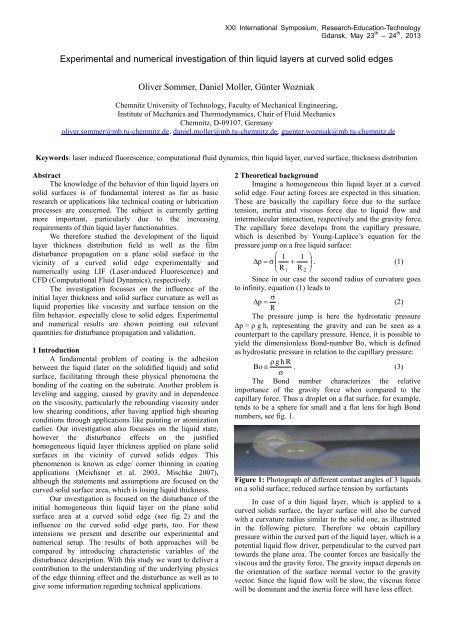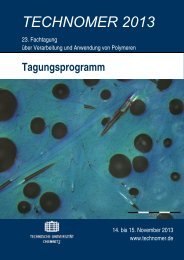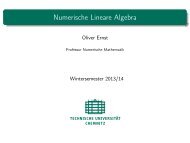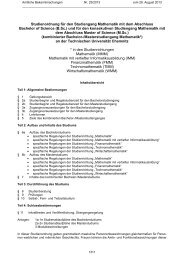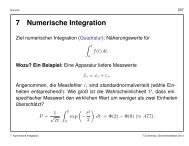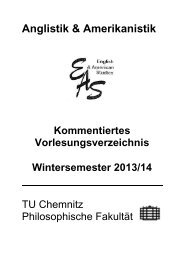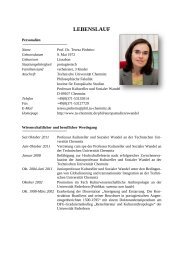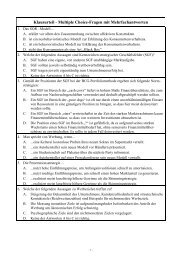Template for the Preparation of Abstract
Template for the Preparation of Abstract
Template for the Preparation of Abstract
Create successful ePaper yourself
Turn your PDF publications into a flip-book with our unique Google optimized e-Paper software.
XXI International Symposium, Research-Education-Technology<br />
Gdansk, May 23 th – 24 th , 2013<br />
Experimental and numerical investigation <strong>of</strong> thin liquid layers at curved solid edges<br />
Oliver Sommer, Daniel Moller, Günter Wozniak<br />
Chemnitz University <strong>of</strong> Technology, Faculty <strong>of</strong> Mechanical Engineering,<br />
Institute <strong>of</strong> Mechanics and Thermodynamics, Chair <strong>of</strong> Fluid Mechanics<br />
Chemnitz, D-09107, Germany<br />
oliver.sommer@mb.tu-chemnitz.de, daniel.moller@mb.tu-chemnitz.de, guenter.wozniak@mb.tu-chemnitz.de<br />
Keywords: laser induced fluorescence, computational fluid dynamics, thin liquid layer, curved surface, thickness distribution<br />
<strong>Abstract</strong><br />
The knowledge <strong>of</strong> <strong>the</strong> behavior <strong>of</strong> thin liquid layers on<br />
solid surfaces is <strong>of</strong> fundamental interest as far as basic<br />
research or applications like technical coating or lubrication<br />
processes are concerned. The subject is currently getting<br />
more important, particularly due to <strong>the</strong> increasing<br />
requirements <strong>of</strong> thin liquid layer functionalities.<br />
We <strong>the</strong>re<strong>for</strong>e studied <strong>the</strong> development <strong>of</strong> <strong>the</strong> liquid<br />
layer thickness distribution field as well as <strong>the</strong> film<br />
disturbance propagation on a plane solid surface in <strong>the</strong><br />
vicinity <strong>of</strong> a curved solid edge experimentally and<br />
numerically using LIF (Laser-induced Fluorescence) and<br />
CFD (Computational Fluid Dynamics), respectively.<br />
The investigation focusses on <strong>the</strong> influence <strong>of</strong> <strong>the</strong><br />
initial layer thickness and solid surface curvature as well as<br />
liquid properties like viscosity and surface tension on <strong>the</strong><br />
film behavior, especially close to solid edges. Experimental<br />
and numerical results are shown pointing out relevant<br />
quantities <strong>for</strong> disturbance propagation and validation.<br />
1 Introduction<br />
A fundamental problem <strong>of</strong> coating is <strong>the</strong> adhesion<br />
between <strong>the</strong> liquid (later on <strong>the</strong> solidified liquid) and solid<br />
surface, facilitating through <strong>the</strong>se physical phenomena <strong>the</strong><br />
bonding <strong>of</strong> <strong>the</strong> coating on <strong>the</strong> substrate. Ano<strong>the</strong>r problem is<br />
leveling and sagging, caused by gravity and in dependence<br />
on <strong>the</strong> viscosity, particularly <strong>the</strong> rebounding viscosity under<br />
low shearing conditions, after having applied high shearing<br />
conditions through applications like painting or atomization<br />
earlier. Our investigation also focusses on <strong>the</strong> liquid state,<br />
however <strong>the</strong> disturbance effects on <strong>the</strong> justified<br />
homogeneous liquid layer thickness applied on plane solid<br />
surfaces in <strong>the</strong> vicinity <strong>of</strong> curved solids edges. This<br />
phenomenon is known as edge/ corner thinning in coating<br />
applications (Meichsner et al. 2003, Mischke 2007),<br />
although <strong>the</strong> statements and assumptions are focused on <strong>the</strong><br />
curved solid surface area, which is losing liquid thickness.<br />
Our investigation is focused on <strong>the</strong> disturbance <strong>of</strong> <strong>the</strong><br />
initial homogeneous thin liquid layer on <strong>the</strong> plane solid<br />
surface area at a curved solid edge (see fig. 2) and <strong>the</strong><br />
influence on <strong>the</strong> curved solid edge parts, too. For <strong>the</strong>se<br />
intensions we present and describe our experimental and<br />
numerical setup. The results <strong>of</strong> both approaches will be<br />
compared by introducing characteristic variables <strong>of</strong> <strong>the</strong><br />
disturbance description. With this study we want to deliver a<br />
contribution to <strong>the</strong> understanding <strong>of</strong> <strong>the</strong> underlying physics<br />
<strong>of</strong> <strong>the</strong> edge thinning effect and <strong>the</strong> disturbance as well as to<br />
give some in<strong>for</strong>mation regarding technical applications.<br />
2 Theoretical background<br />
Imagine a homogeneous thin liquid layer at a curved<br />
solid edge. Four acting <strong>for</strong>ces are expected in this situation.<br />
These are basically <strong>the</strong> capillary <strong>for</strong>ce due to <strong>the</strong> surface<br />
tension, inertia and viscous <strong>for</strong>ce due to liquid flow and<br />
intermolecular interaction, respectively and <strong>the</strong> gravity <strong>for</strong>ce.<br />
The capillary <strong>for</strong>ce develops from <strong>the</strong> capillary pressure,<br />
which is described by Young-Laplace’s equation <strong>for</strong> <strong>the</strong><br />
pressure jump on a free liquid surface:<br />
1 1 <br />
p <br />
<br />
. (1)<br />
R1 R 2 <br />
Since in our case <strong>the</strong> second radius <strong>of</strong> curvature goes<br />
to infinity, equation (1) leads to<br />
<br />
p . (2)<br />
R<br />
The pressure jump is here <strong>the</strong> hydrostatic pressure<br />
p = g h, representing <strong>the</strong> gravity and can be seen as a<br />
counterpart to <strong>the</strong> capillary pressure. Hence, it is possible to<br />
yield <strong>the</strong> dimensionless Bond-number Bo, which is defined<br />
as hydrostatic pressure in relation to <strong>the</strong> capillary pressure:<br />
g h R<br />
Bo . (3)<br />
<br />
The Bond number characterizes <strong>the</strong> relative<br />
importance <strong>of</strong> <strong>the</strong> gravity <strong>for</strong>ce when compared to <strong>the</strong><br />
capillary <strong>for</strong>ce. Thus a droplet on a flat surface, <strong>for</strong> example,<br />
tends to be a sphere <strong>for</strong> small and a flat lens <strong>for</strong> high Bond<br />
numbers, see fig. 1.<br />
Figure 1: Photograph <strong>of</strong> different contact angles <strong>of</strong> 3 liquids<br />
on a solid surface; reduced surface tension by surfactants<br />
In case <strong>of</strong> a thin liquid layer, which is applied to a<br />
curved solids surface, <strong>the</strong> layer surface will also be curved<br />
with a curvature radius similar to <strong>the</strong> solid one, as illustrated<br />
in <strong>the</strong> following picture. There<strong>for</strong>e we obtain capillary<br />
pressure within <strong>the</strong> curved part <strong>of</strong> <strong>the</strong> liquid layer, which is a<br />
potential liquid flow driver, perpendicular to <strong>the</strong> curved part<br />
towards <strong>the</strong> plane area. The counter <strong>for</strong>ces are basically <strong>the</strong><br />
viscous and <strong>the</strong> gravity <strong>for</strong>ce. The gravity impact depends on<br />
<strong>the</strong> orientation <strong>of</strong> <strong>the</strong> surface normal vector to <strong>the</strong> gravity<br />
vector. Since <strong>the</strong> liquid flow will be slow, <strong>the</strong> viscous <strong>for</strong>ce<br />
will be dominant and <strong>the</strong> inertia <strong>for</strong>ce will have less effect.
XXI International Symposium, Research-Education-Technology<br />
Gdansk, May 23 th – 24 th , 2013<br />
Figure 2: Illustration <strong>of</strong> <strong>the</strong> edge/ corner thinning effect and<br />
<strong>the</strong> disturbance effect <strong>of</strong> <strong>the</strong> liquid layer<br />
Once a steady state is reached, a disturbance <strong>of</strong> <strong>the</strong><br />
<strong>for</strong>mer homogeneous liquid layer in <strong>for</strong>m <strong>of</strong> a hump will be<br />
visible. It develops parallel to <strong>the</strong> curved solid edge within<br />
<strong>the</strong> plane solid surface part.<br />
3 Experimental setup<br />
For <strong>the</strong> experiments on <strong>the</strong> liquid layer thickness<br />
distribution <strong>the</strong> so-called Laser-induced Fluorescence<br />
technique LIF was used, which is applied usually <strong>for</strong><br />
measurement and propagation <strong>of</strong> liquid-liquid or sometimes<br />
<strong>of</strong> liquid-gas mixing problems as well as problems in<br />
microbiology, micr<strong>of</strong>luidics and in fluid mechanic heat and<br />
mass transfer problems (Glawdel el al. (2008) and Petracci<br />
et al. (2006)). In this experimental investigation <strong>the</strong> general<br />
idea <strong>of</strong> measuring liquid thickness using LIF, allowing<br />
non-invasive and <strong>the</strong>re<strong>for</strong>e non-destructive detections, is<br />
similar to investigations <strong>of</strong> Ausner et al. (2005) and Ausner<br />
(2006) but in much smaller liquid thickness dimensions and<br />
in different experimental setups.<br />
The need <strong>of</strong> fluorescing substances, which can be<br />
mixed into <strong>the</strong> applied liquid without changing <strong>the</strong> liquid<br />
properties, is mandatory as well as an exciting light source<br />
and a camera device, equipped with optical filters <strong>for</strong> signal<br />
detection. The applied fluorescence substance was mixed<br />
into <strong>the</strong> liquid with a mass weight ratio <strong>of</strong> about 1:10,000,<br />
resulting in negligible changes in liquid properties like<br />
density, viscosity and surface tension. The use <strong>of</strong> suitable<br />
optical filters in front <strong>of</strong> <strong>the</strong> camera device is necessary to<br />
avoid detection <strong>of</strong> disturbing light intensity. In our case we<br />
used a so-called band-pass filter, which permits a light<br />
transparency close to 1.0 in <strong>the</strong> relevant wavelength, while<br />
blocking all o<strong>the</strong>r wavelengths. The exciting light source<br />
was a diode-laser with an emitting wavelength <strong>of</strong><br />
= 532 nm and a constant optical power output <strong>of</strong><br />
P = 40 mW. Equipped with a special optical lens (a so-called<br />
Powell lens), it was possible to achieve an anti-Gaussian<br />
spaced line pr<strong>of</strong>ile <strong>of</strong> <strong>the</strong> laser beam within objective<br />
distances <strong>of</strong> 200 mm ≤ l ≤ ∞.<br />
The typical experimental setup <strong>of</strong> <strong>the</strong> above mentioned<br />
light source, camera device and solid substrate is shown as<br />
schematic in fig. 3. The orthogonal arrangement <strong>of</strong> <strong>the</strong> light<br />
source and <strong>the</strong> camera device to <strong>the</strong> solid substrate is well<br />
visible as well as <strong>the</strong> homogenous distributed laser line<br />
pr<strong>of</strong>ile and <strong>the</strong> band-pass filter in front <strong>of</strong> <strong>the</strong> camera device.<br />
For our needs <strong>of</strong> an objective distance to solid/ liquid surface<br />
l ≥ 0.5 m (space <strong>for</strong> coating application), we used an<br />
objective <strong>of</strong> f = 80 mm focal length in combination with<br />
intermediate rings (50 mm) and yield a photograph (range <strong>of</strong><br />
interest, ROI) <strong>of</strong> about 58.5 mm x 10.5 mm. The camera<br />
device was a b/ w Basler Scout type with a maximum spatial<br />
resolution <strong>of</strong> 1392 Pixel x 1040 Pixel and 12 bit intensity<br />
resolution. The maximum frame grabbing speed was about<br />
17 fps.<br />
Figure 3: Schematic <strong>of</strong> <strong>the</strong> experimental arrangement<br />
For camera controlling a Labview program was written<br />
to apply typical camera and acquisition parameters including<br />
<strong>the</strong> region <strong>of</strong> interest (ROI) and <strong>the</strong> rate <strong>of</strong> visual recording<br />
(fps). A second Labview program was used <strong>for</strong> picture post<br />
processing. Figure 4 shows a typically photograph <strong>of</strong> one<br />
parameter setup <strong>of</strong> <strong>the</strong> liquid layer distribution using <strong>the</strong> LIF<br />
technique. A good visibility has been identified due to <strong>the</strong><br />
higher emitted intensity <strong>of</strong> <strong>the</strong> liquid layer disturbance at <strong>the</strong><br />
solid surface curvature on <strong>the</strong> left side, while <strong>the</strong> rest <strong>of</strong> <strong>the</strong><br />
emitted line has about <strong>the</strong> same intensity.<br />
Figure 4: Photograph <strong>of</strong> a typical liquid layer thickness<br />
distribution at curved solid surface with LIF technique<br />
The corresponding liquid layer thickness distribution,<br />
which is generated by our post processing program, is<br />
measured in dimensionless intensity units and <strong>the</strong> position is<br />
given in Pixel, see fig. 5.<br />
Figure 5: Experimental result <strong>of</strong> a typical liquid layer<br />
intensity distribution at a curved solid surface<br />
This figure also shows <strong>the</strong> respective variables <strong>for</strong> <strong>the</strong><br />
disturbance description <strong>of</strong> <strong>the</strong> homogenous film at <strong>the</strong><br />
curved solid surface, namely <strong>the</strong> bandwidth x, <strong>the</strong><br />
maximum emitted light intensity I max and its position x max .<br />
The averaged intensity I avg at a distance <strong>of</strong> <strong>the</strong> solid surface<br />
curvature is illustrated, too. The ratio <strong>of</strong> justified liquid layer<br />
thickness, which is calculated by multiplication <strong>of</strong> <strong>the</strong><br />
measured solidified thickness with <strong>the</strong> factor 2, and <strong>the</strong><br />
averaged intensity yields in an intensity-liquid thickness<br />
scaling factor b. In <strong>the</strong> same manner <strong>the</strong> geometric scaling<br />
factor a is obtained, here by <strong>the</strong> ratio <strong>of</strong> measured distance in
length unit to <strong>the</strong> counted number <strong>of</strong> Pixel. Using <strong>the</strong>se two<br />
scaling factors, <strong>the</strong> maximum liquid layer thickness and its<br />
position are obtained in length units, see fig. 6.<br />
XXI International Symposium, Research-Education-Technology<br />
Gdansk, May 23 th – 24 th , 2013<br />
The liquid layer maximum thickness s max and its<br />
normalized position to <strong>the</strong> substrate beginning x max are yield<br />
by a polynomial fit <strong>of</strong> <strong>the</strong> intensity values within <strong>the</strong><br />
bandwidth array mentioned earlier, and a following search <strong>of</strong><br />
<strong>the</strong> peak value. Tracked over <strong>the</strong> time <strong>the</strong> normalized<br />
position x max becomes a characteristic velocity <strong>of</strong> <strong>the</strong> rise.<br />
With <strong>the</strong> bandwidth-time plot in mind, <strong>the</strong> plots <strong>of</strong> <strong>the</strong><br />
maximum liquid layer thickness s max , <strong>the</strong> justified liquid<br />
layer thickness s avg as well as <strong>the</strong> ratio s* = s max / s avg <strong>of</strong> both<br />
give a good picture <strong>for</strong> <strong>the</strong> development <strong>of</strong> <strong>the</strong> disturbance<br />
<strong>of</strong> <strong>the</strong> thin liquid layer at solid curved edges in space and<br />
time.<br />
Figure 6: Experimental result <strong>of</strong> a typical liquid layer<br />
thickness distribution at a curved solid surface<br />
The three important variables mentioned be<strong>for</strong>e, are<br />
tracked over <strong>the</strong> time until no more change was visible, see<br />
fig. 7-9. In each diagram <strong>the</strong>re is a black vertical line,<br />
representing <strong>the</strong> end <strong>of</strong> <strong>the</strong> coating application, which means<br />
that at this time, and fur<strong>the</strong>r on, <strong>the</strong> disturbance <strong>of</strong> <strong>the</strong><br />
homogeneous film could develop without external acting<br />
<strong>for</strong>ces <strong>of</strong> <strong>the</strong> atomizer. The bandwidth x is built through an<br />
array length, which contains <strong>the</strong> intensity (thickness) values,<br />
which are 105 % or higher than <strong>the</strong> averaged values from <strong>the</strong><br />
non-influenced area <strong>of</strong> <strong>the</strong> liquid layer, see fig. 5.<br />
Figure 7: Liquid layer bandwidth x tracked over <strong>the</strong> time t<br />
Figure 8: Position <strong>of</strong> <strong>the</strong> maximum liquid layer<br />
thickness x max tracked over <strong>the</strong> time t<br />
Figure 9: Maximum liquid layer thickness s max (blue),<br />
justified liquid layer thickness s avg (red) and relative max.<br />
liquid layer thickness s* (green) at a solid surface edge<br />
tracked over time t<br />
Preconceiving a ratio <strong>of</strong> bandwidth and maximum<br />
liquid layer thickness, this value will represent <strong>the</strong> surface<br />
normal gradient, which will distinguish between good<br />
visible and not so conspicuous disturbances <strong>of</strong> <strong>the</strong><br />
homogeneous liquid layer. Depending on <strong>the</strong> parameter<br />
configuration <strong>the</strong> disturbance rise comes to rest after about<br />
30 to 40 seconds. Curve fitting has been applied to each<br />
variable (fig. 7-9), to yield values describing <strong>the</strong> final steady<br />
state <strong>of</strong> <strong>the</strong> disturbance <strong>of</strong> <strong>the</strong> thin liquid layer at curved<br />
solid edges.<br />
4 Numerical setup<br />
For <strong>the</strong> numerical approach we used a commercial<br />
available CFD code, termed STAR-CCM + from <strong>the</strong><br />
company cd-adapco. This s<strong>of</strong>tware contains different<br />
methods <strong>for</strong> modeling multiphase flows. Since we are<br />
interested in <strong>the</strong> resolving and tracking <strong>of</strong> <strong>the</strong> liquid-gas<br />
interface, i.e. <strong>the</strong> liquid surface curvature and thus <strong>the</strong><br />
capillary pressure, <strong>the</strong> use <strong>of</strong> <strong>the</strong> Eulerian approach based<br />
Volume <strong>of</strong> Fluid Method (VOF) has been applied. This<br />
method uses <strong>the</strong> level-set method by Brackbill et al. (1992)<br />
and is capable to simulate and to display <strong>the</strong> liquid surface<br />
<strong>of</strong> a liquid-gas fluid arrangement, e.g. <strong>the</strong> liquid depth or<br />
wave height in typical marine applications.<br />
Our interest lies in <strong>the</strong> liquid depth, particularly in <strong>the</strong><br />
liquid layer thickness on a curved solid substrate in<br />
connection with capillary pressure and corresponding<br />
capillary <strong>for</strong>ces driven effects on <strong>the</strong> homogenous justified<br />
film. Beside <strong>the</strong> VOF model, o<strong>the</strong>r physical models were<br />
applied like gravity, laminar flow and transient time regime.<br />
In a similar manner liquid and gas properties (see table 1),<br />
boundary and initial conditions were set.
Table 1: typical fluid property configuration<br />
liquid<br />
gas<br />
= 1,020 kg/ m 3 = 1.184 kg/ m 3<br />
(t) = 0.2 Pa s + 0.02 Pa ∙ t = 0.018 mPa s<br />
= 28.0 mN/ m<br />
The following two pictures show a typical simulation<br />
at <strong>the</strong> beginning and <strong>the</strong> result after 20 seconds. Clearly<br />
visible, a homogeneous thin liquid layer <strong>of</strong> justified<br />
thickness and surface curvatures exists. The liquid layer<br />
thickness is displayed as scalar field on <strong>the</strong> liquid surface as<br />
a blue to red scale, where blue indicates small values and red<br />
bigger thicknesses. With <strong>the</strong> intension <strong>of</strong> reducing<br />
computational ef<strong>for</strong>t, two different solid surface curvatures<br />
were applied. On <strong>the</strong> left side we always found a bigger<br />
curvature radius than on <strong>the</strong> right side and <strong>the</strong> plane area<br />
situated between <strong>the</strong> two curved parts was built large enough<br />
to avoid overlapping <strong>of</strong> both developing humps.<br />
XXI International Symposium, Research-Education-Technology<br />
Gdansk, May 23 th – 24 th , 2013<br />
The bandwidth x and <strong>the</strong> maximum liquid layer<br />
thickness s max and its position x max were evaluated and<br />
plotted over <strong>the</strong> time, likewise in <strong>the</strong> experimental post<br />
processing.<br />
An effective simulation means an optimal spatial and<br />
temporal resolution in combination with <strong>the</strong> time ef<strong>for</strong>t <strong>of</strong><br />
one simulation including post processing. Thus, verification<br />
simulations with different resolutions <strong>of</strong> <strong>the</strong> numeric mesh<br />
and transient time steps were per<strong>for</strong>med (fig. 13). It turned<br />
out that a mesh with about 1 million elements in<br />
combination with a transient time step <strong>of</strong> t = 0.001 s was<br />
<strong>the</strong> best compromise between numeric accuracy and real<br />
time ef<strong>for</strong>t. Here a local spatial resolution <strong>of</strong> 1 % to 5 % <strong>of</strong><br />
<strong>the</strong> quarter circumference, built by <strong>the</strong> solid surface<br />
curvature, was applied in combination with an equidistantly<br />
grown boundary layer mesh, which allowed a liquid<br />
thickness resolution <strong>of</strong> about 2.0 µm.<br />
Figure 10: Initial liquid layer thickness distribution at t = 0 s<br />
Figure 13: Numerical verification <strong>of</strong> <strong>the</strong> model using<br />
different spatial and temporal resolutions<br />
The following three pictures (fig. 14-16) show <strong>the</strong> time<br />
plots <strong>of</strong> <strong>the</strong> bandwidth x, <strong>the</strong> maximum liquid layer<br />
thickness s max and its position x max at <strong>the</strong> plane solid surface,<br />
likewise in <strong>the</strong> experiment.<br />
Figure 11: Liquid layer thickness distribution at t = 20 s<br />
For post processing, <strong>the</strong> liquid layer thickness<br />
distribution in <strong>the</strong> middle <strong>of</strong> <strong>the</strong> substrate’s height is<br />
extracted as a line probe every second and plotted over <strong>the</strong><br />
plane area position, see fig. 12.<br />
Figure 14: Liquid layer bandwidth x versus <strong>the</strong> time t<br />
Figure 12: Numerical result <strong>of</strong> a typical liquid layer<br />
thickness distribution at curved solid surfaces at t = 20 s<br />
The bandwidth x decreases with time in <strong>the</strong> same<br />
manner as in <strong>the</strong> experiments. This also is <strong>the</strong> case <strong>for</strong> <strong>the</strong><br />
maximum liquid layer thickness position time plot as well as<br />
<strong>the</strong> maximum liquid layer thickness sequence. A curve<br />
fitting was applied to <strong>the</strong> numerically achieved<br />
bandwidth x, <strong>the</strong> position x max and height <strong>of</strong> <strong>the</strong> maximum<br />
liquid layer thickness s max to get <strong>the</strong> steady state values <strong>of</strong><br />
<strong>the</strong> problem.
XXI International Symposium, Research-Education-Technology<br />
Gdansk, May 23 th – 24 th , 2013<br />
<strong>the</strong> numerical time, which is identical to <strong>the</strong> application<br />
duration <strong>of</strong> <strong>the</strong> experimental application.<br />
Figure 15: Position <strong>of</strong> <strong>the</strong> maximum liquid layer thickness<br />
x max tracked over <strong>the</strong> time t<br />
Figure 17: Comparison <strong>of</strong> experimental (blue dots) and<br />
numerical results (red line); bandwidth x versus time t<br />
Figure 16: Maximum liquid layer thickness s max<br />
(blue: r C = 3.0 mm, red: r C = 2.0 mm) close to <strong>the</strong> solid<br />
surface curvature and relative max. liquid layer thickness s*<br />
(green: r C , violet: r C ) tracked as a function <strong>of</strong> time t<br />
Since <strong>the</strong> computational resources were limited, <strong>the</strong><br />
simulation time ended with 20 seconds in each simulation<br />
run. This duration was adequate <strong>for</strong> a good comparison <strong>of</strong><br />
<strong>the</strong> experimental and numerical results, because <strong>the</strong><br />
diagrams 14-16 show that <strong>the</strong>re were no more drastic<br />
changes expected.<br />
5 Results and discussion<br />
The following 3 diagrams illustrate <strong>the</strong> liquid layer<br />
bandwidth x, <strong>the</strong> maximum liquid layer thickness<br />
position x max and <strong>the</strong> maximum liquid layer thickness s max<br />
over <strong>the</strong> time t <strong>of</strong> one experimental (blue dots) and one<br />
numerical result (red line), which were per<strong>for</strong>med with an<br />
identical parameter setup. It is clearly visible, that <strong>the</strong>y fit<br />
each o<strong>the</strong>r quite well. Very small deviations are only visible<br />
between <strong>the</strong> experimental dots and <strong>the</strong> numerical lines<br />
within <strong>the</strong> 12 th to <strong>the</strong> 30 th second. This can be explained by<br />
<strong>the</strong> small errors which occur in both investigation<br />
approaches through <strong>the</strong> compromises, which had to be<br />
applied, facilitating this investigation in general.<br />
Never<strong>the</strong>less <strong>the</strong> time dependent functions <strong>of</strong> <strong>the</strong> chosen<br />
variables <strong>for</strong> <strong>the</strong> disturbance description are very similar and<br />
<strong>the</strong>re<strong>for</strong>e <strong>the</strong> steady state values are very close to equality.<br />
The numerical curves always begin later with time<br />
than <strong>the</strong> experimental ones. This is due to <strong>the</strong> ideal initial<br />
conditions in <strong>the</strong> numerical simulation. Here we could set a<br />
homogeneous distributed liquid film <strong>of</strong> desired thickness at<br />
<strong>the</strong> beginning, while in <strong>the</strong> experiments we had to apply it<br />
first by a suitable application. Thus we set an <strong>of</strong>fset-time to<br />
Figure 18: Comparison <strong>of</strong> experimental and numerical<br />
results; maximum thickness position x max versus time t<br />
Figure 19: Comparison <strong>of</strong> experimental (blue dots) and<br />
numerical results (red line); maximum liquid layer thickness<br />
s max versus time t<br />
These diagrams also show that our chosen total<br />
simulation time, which is smaller than <strong>the</strong> experimental time,<br />
is well suitable to predict <strong>the</strong> liquid layer thickness<br />
distribution and <strong>the</strong>re<strong>for</strong>e <strong>the</strong> disturbance <strong>of</strong> thin liquid<br />
layers at curved solid edges. Fur<strong>the</strong>rmore, <strong>the</strong> simulation<br />
shows <strong>the</strong> liquid layer thickness distribution on <strong>the</strong> curved<br />
part <strong>of</strong> a solid, too. Thus a prediction <strong>of</strong> <strong>the</strong> edge/ corner<br />
thinning effect would also be possible, fig. 20.
XXI International Symposium, Research-Education-Technology<br />
Gdansk, May 23 th – 24 th , 2013<br />
T. Glawdel et al., Photobleaching absorbed Rhodamine B to<br />
improve temperature measurements in PDMS microchannels.<br />
Lab on Chip, Vol. 9, 171-174 (2009)<br />
A. Petracci, R. Delfos, J. Westerweel, Combined PIV/LIF<br />
measurements in a Rayleight-Bénard convection cell. 13 th<br />
Int. Symp. on Applications <strong>of</strong> Laser Techniques to Fluid<br />
Mechanics, Lisbon, Portugal (2006)<br />
Figure 20: Liquid layer thickness distribution on a curved<br />
solid surface at t = 20.0 s<br />
6 Concluding remarks and outlook<br />
In this investigation we studied <strong>the</strong> possibility <strong>of</strong> an<br />
experimental measurement and a numerical simulation <strong>of</strong><br />
<strong>the</strong> transient development <strong>of</strong> <strong>the</strong> disturbance <strong>of</strong> a thin liquid<br />
layer at a curved solid edge and in <strong>the</strong> steady state. For this<br />
we developed a suitable experimental setup with a<br />
self-written program code <strong>for</strong> semi-automatic post<br />
processing. A suitable numerical approach was established,<br />
too. We identified convenient variables <strong>for</strong> <strong>the</strong> description <strong>of</strong><br />
<strong>the</strong> disturbance development and <strong>for</strong> an interpretation in<br />
view <strong>of</strong> technical applications. The experimental and<br />
numerical results fit each o<strong>the</strong>r very well, so that predictions<br />
<strong>of</strong> <strong>the</strong> liquid layer thickness distributions on solid surfaces<br />
are possible. Fur<strong>the</strong>rmore <strong>the</strong> numerical approach is capable<br />
to give results describing <strong>the</strong> edge thinning effect.<br />
Future investigations as well as already on-going<br />
studies are focused on <strong>the</strong> influences <strong>of</strong> <strong>the</strong> dependencies <strong>of</strong><br />
typical technical parameters and liquid properties. However<br />
<strong>the</strong> normal orientation vector <strong>of</strong> <strong>the</strong> substrate, material and<br />
roughness <strong>of</strong> <strong>the</strong> substrate as well as o<strong>the</strong>r coating<br />
applications will be taken into account, too.<br />
I. Ausner, A. H<strong>of</strong>fmann, J.-U. Repke and G. Wozny,<br />
Experimentelle und numerische Untersuchungen<br />
mehrphasiger Filmströmungen. Chemie Ingenieur Technik,<br />
Vol. 77, No. 6, 735-741 (2005)<br />
I. Ausner, Experimentelle Untersuchungen mehrphasiger<br />
Filmströmungen. Dissertation, TU Berlin (2006)<br />
H. Du et al., PhotochemCAD: A computer-aided design and<br />
research tool in photochemistry. Photochem. Photobiol. Vol.<br />
68 (2), 141-142 (1998)<br />
J.U. Brackbill, D.B. Ko<strong>the</strong> and C. Zemach, A Continuum<br />
Method <strong>for</strong> Modeling Surface Tension, Journal <strong>of</strong><br />
Computational Physics, Vol. 100, 335-354 (1992)<br />
T.G. Mezger, Das Rheologie Handbuch, Vincentz Network,<br />
Hannover (2010)<br />
Nomenclature<br />
symbol description unit<br />
a geometric scale factor [mm/ px]<br />
b intensity-liquid thickness scale factor [µm/ -]<br />
I avg averaged emitted light intensity [-]<br />
I max maximum emitted light intensity [-]<br />
r C solid surface curvature radius [mm]<br />
r l liquid surface curvature radius [mm]<br />
s avg justified liquid layer thickness [µm]<br />
s max maximum liquid layer thickness [µm]<br />
s* relative maximum liquid layer thickness [%]<br />
t time [s]<br />
x max maximum liquid layer thickness position [mm]<br />
x liquid layer disturbance bandwidth [mm]<br />
<br />
viscosity [Pa s]<br />
density [kg/ m 3 ]<br />
surface tension [mN/ m]<br />
References<br />
G. Meichsner, T.G. Mezger, J. Schröder, Lackeigenschaften<br />
messen und steuern. Coatings Compendien, Vincentz<br />
Network, Hannover (2003)<br />
P. Mischke, Filmbildung. Filmbildung in modernen<br />
Lacksystemen. Vincentz Network, Hannover (2007)


